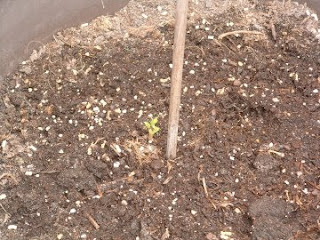The biggest problem with growing barley, I’m finding, is observing the progress. On the one hand, brewing is a hobby for the patient–it’s all “hurry up and wait,” after all. On the other hand, watching barley grow is rather like–well, not to put too fine a point on it, it’s like watching grass grow. (Makes sense, really, since that’s exactly what it is…) At least with the hops you can see progress on a daily basis.
So, everything has germinated. The Maris Otter and Halcyon are nearing the tops of their “cages”. The Hana and Bere are a ways behind that. I’m disappointed with the germination rate I got from the Hana in the field–of the 30-40 seeds, I’ve got maybe ten sprouts. (All of the Hana in the planter came up–it’s likely a soil issue, rather than a seed issue.) The Bere is happy both in the field and the planter, with its second set of leaves up and the third set looking not far behind.
In the meantime, with less than two weeks to go before their introduction, I’m feverishly going over, revising, and correcting my class notes for the Medieval German Beer classes. There are three, tentatively titled: “Period German Brewing Practices,” “Medicinal German Beers,” and “A Period German Pub Crawl.” Thus far, the corrections are primarily fixing typos, and making sure my facts line up. Of the three, I’m happiest with the Pub Crawl; it’s entirely possible that in the future I’ll fold the Period Practices bit into that one for a “mega-class”. I’m hoping to have some medicinal herb people in the Medicinal Beers class, and to make it more of a discussion group.
Part of the fun for the Pub Crawl was looking at the various local beer names–“brands,” if you will. A friend of mine was commenting on the wide variety of beer names available at the local liquor superstore, and the humor value in many of them… Well, our ancestors were no different in that regard: Butterfly, Toad, Choir Finch, Mosquito Mustard, and Raving Man are among the less vulgar names. Some of them describe the feeling, or aftereffect, of the beer: Body-blow, Rip-Head, Blow-the-Man-Down. The Lubeck offering of “Israel” was so named because of its strength: “People strive with it as Jacob wrestled with the Angel.” (“Israel” is from the Hebrew for “wrestles with God”.)
Surprisingly, only a few of the beers were familiar to me, in terms of historical offerings: Gose, Israel, Broihane, Alt Klaus, Joben, and Mumme. Of those, I have only ever tasted commercial Gose. (Mumme has become non-alcoholic, while Broihane morphed into a Pilsner, apparently. I have practically no information whatsoever on Alt Klaus or Joben.) Bock was not mentioned as such, although it was present if you know where to look–it derived from the name of its town of origin, Einbeck. Indeed, it was searching for information on period “Einbeckisch Bier” that led me to the sources for my classes.
I’ll try to update again, either as “teaching-day” approaches, or soon after… And, I promise, pictures of barley (and hops!) will be forthcoming before long.










